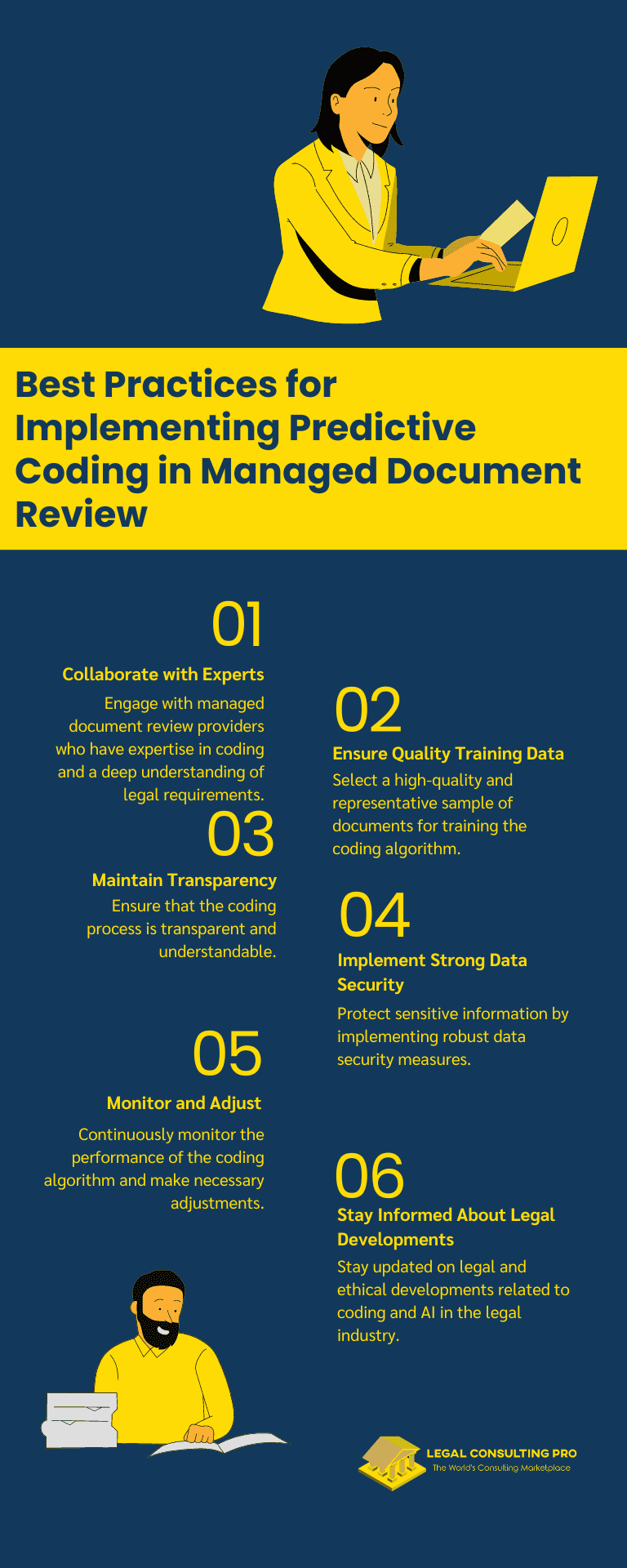In the realm of legal technology, predictive coding has emerged as a groundbreaking tool that revolutionizes managed document review. This AI-driven approach leverages machine learning algorithms to streamline the review process, enhancing efficiency, accuracy, and cost-effectiveness. This article delves into the intricacies of coding, exploring its impact on document review and how it is transforming legal practices.
Understanding Predictive Coding
Predictive coding, also known as technology-assisted review (TAR), is a machine-learning technique used to identify and classify relevant documents within large datasets. It involves training a computer algorithm with a set of pre-coded documents, allowing the system to learn and predict the relevance of new, uncoded documents. This process significantly accelerates the document review phase in legal proceedings.
How Predictive Coding Works
- Training Phase: Legal professionals manually review and code a subset of documents, marking them as relevant or irrelevant. This initial set serves as the training data for the coding system.
- Algorithm Training: The machine learning algorithm analyzes the coded documents, identifying patterns and criteria that distinguish relevant documents from irrelevant ones.
- Prediction Phase: The algorithm applies the learned patterns to the entire dataset, predicting the relevance of uncoded documents. These predictions help prioritize which documents should be reviewed by humans.
- Validation and Iteration: To ensure accuracy, a sample of the algorithm’s predictions is manually reviewed. The feedback from this review is used to refine the algorithm, improving its predictive capabilities. This iterative process continues until the desired accuracy level is achieved.
Benefits of Predictive Coding
The integration of coding into managed document review offers numerous benefits, including:
- Efficiency: Coding significantly reduces the time required to review large volumes of documents. By automating the initial review process, legal teams can focus their efforts on analyzing the most relevant documents.
- Cost Savings: Reducing the number of documents requiring manual review translates to substantial cost savings. This is particularly advantageous in large-scale litigation where document review constitutes a significant portion of legal expenses.
- Accuracy: Machine learning algorithms can analyze documents with a high degree of accuracy, minimizing the risk of human error. This enhances the reliability of the document review process.
- Consistency: Coding ensures a consistent review standard, as the algorithm applies the same criteria across all documents. This consistency is challenging to achieve with manual review alone.
The Role of Managed Document Review in Predictive Coding
Managed document review involves outsourcing document review tasks to specialized service providers. These providers utilize advanced technologies, including coding, to efficiently manage large-scale document reviews. The synergy between coding and document review maximizes the benefits of both approaches.
Implementation of Predictive Coding in Managed Document Review
- Assessment and Planning: The managed document review provider assesses the scope and requirements of the review project. This includes understanding the dataset size, complexity, and specific legal needs.
- Selection of Technology: Advanced coding tools and platforms are selected based on the project’s requirements. These tools are tailored to handle the nuances of legal documents, including various formats and languages.
- Training the Algorithm: Legal experts from the document review team train the coding algorithm using a representative sample of documents. Their expertise ensures the algorithm is accurately trained to identify relevant documents.
- Ongoing Monitoring and Adjustment: Throughout the review process, the managed document review team continuously monitors the algorithm’s performance. Adjustments are made as necessary to improve accuracy and ensure compliance with legal standards.
Case Studies: Success Stories in Predictive Coding and Managed Document Review
Case Study 1: Large-Scale Litigation
A multinational corporation faced a complex litigation case involving millions of documents. The sheer volume made manual review impractical. By partnering with a document review provider and utilizing coding, the corporation significantly reduced the number of documents requiring manual review. This approach not only accelerated the review process but also resulted in considerable cost savings. The coding algorithm’s high accuracy ensured that all relevant documents were identified and analyzed, contributing to a favorable legal outcome.
Case Study 2: Regulatory Compliance
A financial services firm needed to review extensive documentation to ensure compliance with new regulatory requirements. The firm employed a managed document review provider with expertise in coding. The provider’s technology quickly identified documents containing sensitive information and potential compliance issues. The firm’s legal team focused their efforts on these high-priority documents, ensuring timely compliance with the new regulations. The integration of coding streamlined the review process, making it both efficient and cost-effective.
Challenges and Considerations in Predictive Coding
While coding offers significant advantages, its implementation in document review also presents challenges that must be addressed:
- Training Data Quality: The accuracy of coding relies heavily on the quality of the training data. Inaccurate or biased training data can lead to incorrect predictions. It is crucial to select a representative and well-coded sample of documents for training.
- Algorithm Transparency: Understanding how the coding algorithm makes decisions is essential for ensuring its reliability. Legal professionals must have insights into the algorithm’s workings to validate its predictions and address any concerns about bias.
- Data Security and Privacy: Managed document review often involves sensitive and confidential information. Ensuring the security and privacy of this data during the coding process is paramount. Service providers must implement robust security measures to protect client data.
- Legal and Ethical Considerations: The use of AI and coding in legal contexts raises ethical and legal questions. Ensuring compliance with legal standards and addressing potential ethical issues, such as bias and fairness, is critical.
Best Practices for Implementing Predictive Coding in Managed Document Review
To maximize the benefits of coding and document review, legal professionals should adhere to best practices:
- Collaborate with Experts: Engage with managed document review providers who have expertise in coding and a deep understanding of legal requirements. Their knowledge and experience are invaluable in training the algorithm and managing the review process.
- Ensure Quality Training Data: Select a high-quality and representative sample of documents for training the coding algorithm. Regularly review and update the training data to maintain the algorithm’s accuracy.
- Maintain Transparency: Ensure that the coding process is transparent and understandable. Legal professionals should be able to explain how the algorithm makes decisions and validate its predictions.
- Implement Strong Data Security: Protect sensitive information by implementing robust data security measures. Ensure that document review providers adhere to stringent security protocols to safeguard client data.
- Monitor and Adjust: Continuously monitor the performance of the coding algorithm and make necessary adjustments. Regular validation and refinement of the algorithm enhance its accuracy and reliability.
- Stay Informed About Legal Developments: Stay updated on legal and ethical developments related to coding and AI in the legal industry. Adapting to new regulations and best practices ensures ongoing compliance and ethical use of technology.

Future Trends in Predictive Coding and Managed Document Review
The future of coding and document review is poised for exciting advancements. Emerging trends include:
- Enhanced AI Capabilities: Ongoing advancements in AI and machine learning will further improve the accuracy and efficiency of coding. More sophisticated algorithms will be able to handle increasingly complex document review tasks.
- Integration with Other Legal Technologies: Coding will be integrated with other legal technologies, such as e-discovery platforms and legal analytics tools. This integration will create a seamless workflow for managing large-scale document reviews.
- Increased Adoption in Smaller Firms: As coding technology becomes more accessible and cost-effective, smaller law firms and organizations will increasingly adopt it. This democratization of technology will enable a broader range of legal professionals to benefit from coding.
- Focus on Ethical AI: The legal industry will place greater emphasis on ethical AI practices. Efforts to address bias, transparency, and fairness in coding algorithms will be prioritized to ensure the ethical use of technology.
- Regulatory Developments: As the use of AI in legal contexts grows, new regulations and guidelines will emerge to govern its use. Legal professionals must stay informed about these developments to ensure compliance and ethical use of coding.
Conclusion
Predictive coding is revolutionizing managed document review, offering unparalleled efficiency, accuracy, and cost savings. By leveraging machine learning algorithms, legal professionals can streamline the document review process, focusing their efforts on the most relevant documents. Document review providers play a crucial role in implementing coding, and offering expertise, technology, and resources to maximize its benefits.
Despite its advantages, coding presents challenges that must be addressed, including ensuring quality training data, maintaining algorithm transparency, and protecting data security. By adhering to best practices and staying informed about future trends, legal professionals can harness the power of coding to transform document review and achieve favorable legal outcomes.
As coding technology continues to evolve, its impact on the legal industry will only grow, making it an indispensable tool for modern legal practices.
Similar Blogs:
4 Effective Strategies for Identifying Privileged Communications in Managed Reviews













































